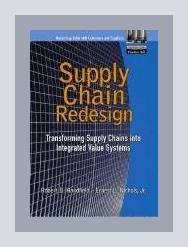Operations and Supply Chain ManagementOperations Strategy
Supply Chain Redesign: Transforming Supply Chains into Integrated Value Systems by Robert B. Handfield and Ernest L. Nichols is a comprehensive examination of how firms can transform their traditional linear supply chains into interconnected, dynamic value networks. Given its focus within the category of Operations Strategy, this book provides actionable insights on optimizing supply chain performance to deliver superior operational and financial performance. Below is a structured summary that covers major points, concrete examples, and practical actions that can be taken:
1. Understanding the Need for Supply Chain Redesign
- Major Point: Changes in the Business Environment
- Example: The authors highlight the competitive pressures faced by firms like Dell and Walmart, which demand faster response times and greater adaptability.
-
Action: Conduct a thorough environmental scan to understand the evolving market demands and competitive landscape.
-
Major Point: Technological Advancements
- Example: The use of RFID technology for tracking inventory in real-time is discussed.
- Action: Invest in new technologies such as RFID for inventory management to enhance visibility and control.
2. Moving Towards an Integrated Supply Network
- Major Point: Transition from Linear to Network-Based Models
- Example: Cisco’s strategy of integrating suppliers into a collaborative network to enhance product innovation and reduce lead times.
-
Action: Build strategic partnerships and collaboratively plan with suppliers to create a more responsive supply chain.
-
Major Point: Creating Value Networks
- Example: The authors mention Zara’s agile supply network which integrates design, production, and distribution closely with market trends.
- Action: Develop cross-functional teams that include members from design, production, and marketing to foster better coordination and agility.
3. Leveraging Information Technology
- Major Point: Role of IT in Supply Chain Integration
- Example: The implementation of ERP systems by companies like SAP to streamline processes and provide real-time data access.
- Action: Implement or upgrade ERP systems to enhance data transparency and decision-making capabilities across the supply chain.
4. Aligning Supply Chain Strategies with Business Goals
- Major Point: Strategic Alignment
- Example: Procter & Gamble’s alignment of their supply chain strategy with their overall business strategy to ensure consistency in objectives.
- Action: Regularly review and align supply chain objectives with the overarching business goals to ensure strategic cohesion.
5. Supply Chain Performance Measurement
- Major Point: Metrics and KPIs
- Example: Use of the balanced scorecard approach by firms to measure supply chain performance along key dimensions like cost, quality, and cycle time.
- Action: Establish a robust performance measurement system using KPIs such as order accuracy, on-time delivery, and inventory turnover.
6. Building a Resilient Supply Chain
- Major Point: Risk Management
- Example: Toyota’s approach to diversifying suppliers and maintaining buffer inventory to manage disruptions.
- Action: Develop a comprehensive risk management strategy that includes supplier diversification and contingency planning.
7. Supplier Relationship Management
- Major Point: Collaborating with Suppliers
- Example: Honda’s collaborative approach with suppliers to not only ensure timely delivery but also drive joint innovation.
- Action: Establish long-term, collaborative relations with key suppliers to improve mutual benefits and drive innovation.
8. Customer-Centric Supply Chains
- Major Point: Enhancing Customer Experience
- Example: Amazon’s customer-centric model that leverages supply chain capabilities to provide fast delivery and easy returns.
- Action: Focus on end-customer needs and design the supply chain to provide excellent service, fast deliveries, and flexible return policies.
9. Sustainable Supply Chain Practices
- Major Point: Incorporating Sustainability
- Example: The authors reference Nike’s shift towards more sustainable sourcing and production practices.
- Action: Integrate sustainability initiatives within the supply chain by focusing on sustainable sourcing and reducing waste.
10. Continuous Improvement and Innovation
- Major Point: Embracing Lean and Six Sigma
- Example: General Electric’s use of Six Sigma methodologies to continuously improve supply chain efficiency.
- Action: Implement Lean and Six Sigma practices to systematically identify and eliminate waste and variability in processes.
Conclusion
Supply Chain Redesign emphasizes that transforming a supply chain into an integrated value system requires a cohesive strategy, leveraging technology, maintaining strategic alignments, fostering collaborations, focusing on customer needs, and driving continuous improvement. Companies that successfully undertake these transformations are well-positioned to thrive in an increasingly competitive and dynamic business environment. Each chapter of the book concludes with actionable steps, making it not just theoretical but highly practical for supply chain professionals looking to implement these strategies.
